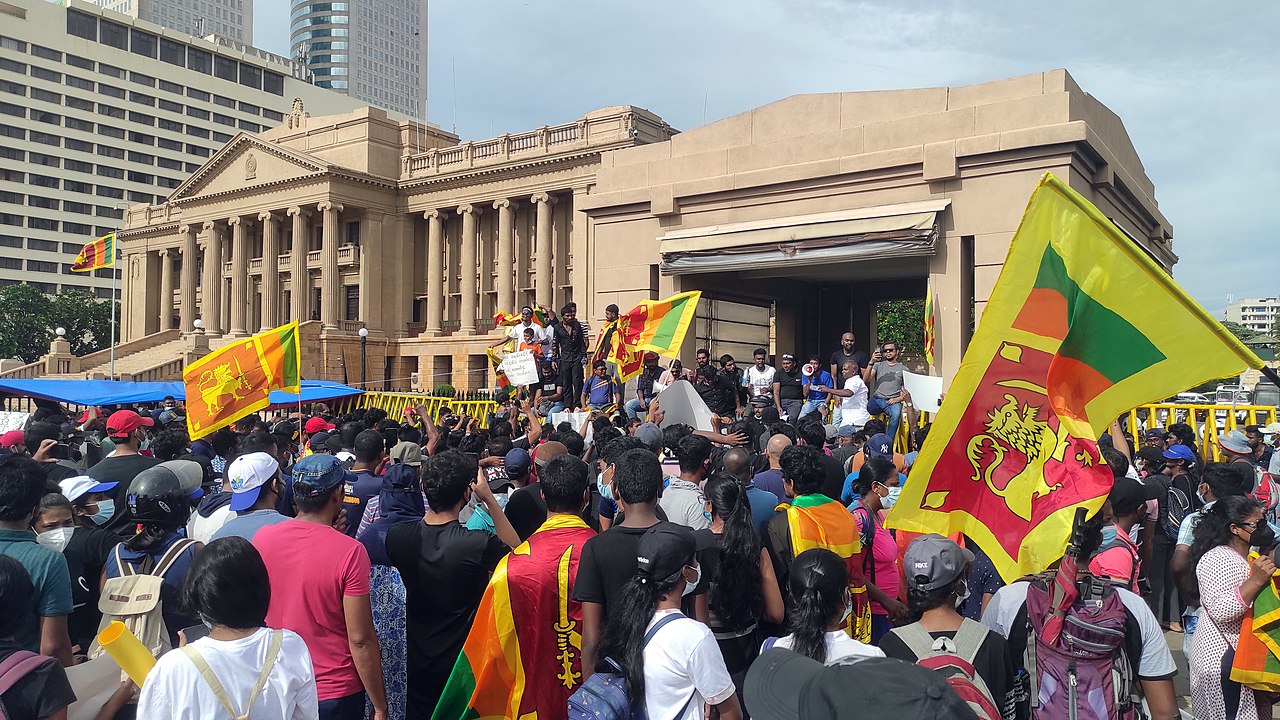
What on Earth Happened in Sri Lanka? Presidential Resignation, Protestors in the Palace, and an Unresolved Crisis
Anyone with a younger brother knows they have a penchant for breaking things that you build - as exiled and former president Gotabaya Rajapaksa seems to have just done with the political dynasty established by his brother Mahinda Rajapaksa in 2005. After defeating the infamous Tamil Tiger insurgent movement, the Rajapaksas got carte-blanche to remake Sri Lankan politics in their image, thereafter amending the constitution and establishing the Executive Presidency. This new office had far more power than before, and for a decade they were the preeminent force in domestic politics. From 2005 until 2015, Gotabaya Rajapaksa was the Defense Secretary under President Mahinda. This meant that he was a newcomer to electoral politics when, in 2019, he won the presidency in a landslide victory on a platform of Sinhalese nationalism. Yet after decades in power, and a former stranglehold on Sri Lankan politics, the Rajapaksa dynasty has collapsed after numerous disastrous policy decisions, an ongoing economic crisis, and the largest sustained protest movement in the nation’s history, since its independence in 1948.
Since mid-March, thousands of protestors have been out in the streets of the capital, Columbo, and the countryside nearly every day, at certain points swelling to tens of thousands. Unprecedented shortages of food and fuel along with record inflation and blackouts inflicted widespread discontent in Sri Lanka. Since January, inflation has risen above 50%, pushing more than 2 million people (9% of the population) below the poverty line. Additionally, a critical lack of foreign currency has left Sri Lanka struggling to service its ballooning $51bn foreign debt, which led Sri Lanka to default on its debt, in April this year, for the first time in its history.
At the end of 2019, Sri Lanka had $7.6bn in foreign currency reserves, which have dropped to around $250m. A number of policies by then president Rajapaksa played a major role in draining the federal coffers. Large tax cuts he introduced in 2019 to boost domestic support lost the government more than $1.4bn annually, and ill-advised use of commercial loans held at much higher interest rates to build flashy new infrastructure projects were already overstretching the Sri Lankan economy. In 2019, 56% of Sri Lanka’s debt was held by commercial lenders, compared to only 2.5% in 2004. And that was before Covid tanked the entire global tourist and foreign remittance economy overnight (the two largest sources of foreign currency reserves for Sri Lanka). Moreover, Sri Lanka now imports $3bn more than it exports every year.
This is also partly thanks to a shortsighted policy implemented by Rajapaksa. When Sri Lanka's foreign currency shortages became a serious problem in early 2021, Gotabaya decided to ban chemical fertilizers (which were imported) to make Sri Lankan farming “all organic” — a move that devastated the tea industry, Sri Lanka’s main export crop. Yet, tea was not the only agricultural product affected, in fact all food production suffered, and the ongoing global grain shortages due to the war in Ukraine have driven rising food insecurity on the island nation. According to Ahilan Kadirgamar, a political economist at the University of Jaffna, "compared with six months ago, the price of bread has tripled, the price of rice has tripled, the prices of petrol and diesel have more or less tripled.” Coupled with inflation, that's about 6 times less buying power than at the start of the year.
The World Food Program's most recent analysis reported that 86% of families were either skipping meals, eating less or buying worse food. Ahilan Kadirgamar, further stated, “The straw that broke the camel’s back was [when Rajapaksa] tried to militarize and privatize education. The teachers, the students, university teachers—all of us started to protest”. Lingering frustrations from the disastrous fertilizer ban also rapidly mobilized the rural agricultural communities once the protests began in Columbo.
However, along with rising prices, the people have had rising voices. Basil Rajapaksa stepped down as Minister of Finance in April, as the entire cabinet resigned, and he tried unsuccessfully to leave the country in May. Then Prime Minister Mahinda Rajapaksa stepped down and parliament was dissolved on May 9. Crowds gathered daily outside the President’s office calling for him to resign, with “Gota Go Home” - the mantra of the demonstrations. On May 12th, Rajapaksa appointed Ranil Wickremesinghe, an establishment figure who had already been Prime minister 6 times, for another stint in the office. However, on July 9th protestors occupied the presidential palace and burned the Prime Minister’s house.
On July 14th, the 96th day of mass protest, President Rajapaksa resigned via email from his self-exile, or rather, escape to the Maldives. This marked the achievement of one of the protest movements key demands. Last month, the loosely organized leadership of the movement articulated their demands in the July 5th Action plan:
(1) Gotabaya Rajapaksha should immediately resign as president; (2) PM Ranil Wickremesinghe and his government should also quit immediately; (3) An interim government should be established for a maximum period of one year; (4) A new constitution that endorses people’s sovereignty be established through a referendum, hopefully within a year; (5) President’s executive powers should be reduced and democratic institutions strengthened until the new constitution is drafted; and (6) The fundamental objective of the interim government should be to implement the above proposals;
In the aftermath of Rajapaksa’s resignation, the Sri Lankan Parliament was left with the task of electing a new president to complete Rajapaksa’s term. In a secret ballot on July 20th, Parliament elected Ranil Wickremesinghe as the acting President of Sri Lanka - much to the dismay of those seeking a compromise coalition to reign in the escalating economic crisis.
Many trade unions warned of a countrywide industrial strike if Wickremesinghe takes over as full-time president. Although there is not yet evidence of union action in Columbo, there is palpable resentment towards Wickremesinghe. Melani Gunathilake, another leader of the protest movement, told al Jazeera that “ what Ranil Wickremesinghe did by accepting the prime minister’s post was more of a betrayal of ‘aragalaya’ [“the struggle”] than a political ploy… We need somebody who can find solutions to our burning issues, not someone who was rejected by the people.” In fact, protestors even burnt an effigy of Wickremesinghe in the streets, according to the Associated Press.
Political stability will be crucial for the negotiation of International Monetary Fund relief or for international aid to reach the country in a timely manner. Unfortunately, former president Rajapaksa’s party (SLPP) still holds a majority in parliament and without their cooperation, a credible government can not be elected and mass protests may continue. Protestors have opposed an all-party government because of Rajapaksa's SLPP majority. Instead, they are calling for an interim government to prepare for elections. The movement does not have centralized leadership, but several socialist student groups have been key organizers, particularly in the capital city of Colombo. However, some of that leadership was arrested in the wake of Wickremesinghe’s parliamentary election as President. If one looks at the exponentially rising inflation in Sri Lanka, it becomes clear that time is running out to get this crisis under control. A stable government will be necessary for any resolution of these compounding issues, and it remains to be seen if one can be found.
